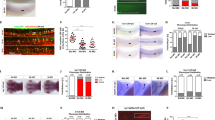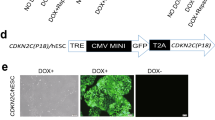Abstract
A pool of stem cells that arise from the mesoderm during embryogenesis initiates hematopoiesis. However, factors that regulate the expansion of blood stem cells are poorly understood. We show here that cytokine-induced proliferation of primitive human hematopoietic cells could be inhibited with antibodies to hedgehog (Hh). Conversely, Sonic hedgehog (Shh) treatment induced the expansion of pluripotent human hematopoietic repopulating cells detected in immunodeficient mice. Noggin, a specific inhibitor of bone morphogenetic protein 4 (BMP-4), was capable of inhibiting Shh-induced proliferation in a similar manner to anti-Hh; however, anti-Hh had no effect on BMP-4–induced proliferation. Our study shows that Shh functions as a regulator of primitive hematopoietic cells via mechanisms that are dependent on downstream BMP signals.
This is a preview of subscription content, access via your institution
Access options
Subscribe to this journal
Receive 12 print issues and online access
$209.00 per year
only $17.42 per issue
Buy this article
- Purchase on Springer Link
- Instant access to full article PDF
Prices may be subject to local taxes which are calculated during checkout







Similar content being viewed by others
References
Dieterlen-Lievre, F., Godin, I. & Pardanaud, L. Where do hematopoietic stem cells come from? Int. Arch. Allergy Immunol. 112, 3–8 (1997).
Morrison, S. J., Wandycz, A. M., Hemmati, H. D., Wright, D. E. & Weissman, I. L. Identification of a lineage of multipotent hematopoietic progenitors. Development 124, 1929–1939 (1997).
Domen, J. & Weissman, I. L. Self-renewal, differentiation or death: regulation and manipulation of hematopoietic stem cell fate. Mol. Med. Today 5, 201–208 (1999).
Dieterlen-Lievre, F. Hematopoiesis: progenitors and their genetic program. Curr. Biol. 8, 727–730 (1998).
Ogawa, M. Differentiation and proliferation of hematopoietic stem cells. Blood 81, 2844–2853 (1993).
Eaves, C. et al. Introduction to stem cell biology in vitro. Threshold to the future. Ann. NY Acad. Sci. 872, 1–8 (1999).
Williams, D. A. Ex vivo expansion of hematopoietic stem and progenitor cells–robbing Peter to pay Paul? Blood 81, 3169–3172 (1993).
Bhatia, M. et al. Bone morphogenetic proteins regulate the developmental program of human hematopoietic stem cells. J. Exp. Med. 189, 1139–1148 (1999).
Mulligan, R. C. The basic science of gene therapy. Science 260, 926–932 (1993).
Halene, S. & Kohn, D. B. Gene therapy using hematopoietic stem cells: sisyphus approaches the crest. Hum. Gene Ther. 11, 1259–1267 (2000).
Dick, J. E. Gene therapy turns the corner. Nature Med. 6, 624–626 (2000).
Mead, P. E. & Zon, L. I. Molecular insights into early hematopoiesis. Curr. Opin. Hematol. 5, 156–160 (1998).
Zon, L. I. Developmental biology of hematopoiesis. Blood 86, 2876–2891 (1995).
Dosch, R., Gawantka, V., Delius, H., Blumenstock, C. & Niehrs, C. Bmp-4 acts as a morphogen in dorsoventral mesoderm patterning in Xenopus. Development 124, 2325–2334 (1997).
Maeno, M. et al. The role of BMP-4 and GATA-2 in the induction and differentiation of hematopoietic mesoderm in Xenopus laevis. Blood 88, 1965–1972 (1996).
Dale, L. & Jones, C. M. BMP signalling in early Xenopus development. Bioessays 21, 751–760 (1999).
Miyazono, K. Positive and negative regulation of TGF-β signaling. J. Cell Sci. 113, 1101–1109 (2000).
Perrimon, N. Hedgehog and beyond. Cell 80, 517–520 (1995).
Farrington, S. M., Belaoussoff, M. & Baron, M. H. Winged-helix, Hedgehog and Bmp genes are differentially expressed in distinct cell layers of the murine yolk sac. Mech. Dev. 62, 197–211 (1997).
Weed, M., Mundlos, S. & Olsen, B. R. The role of sonic hedgehog in vertebrate development. Matrix Biol. 16, 53–58 (1997).
Roberts, D. J. et al. Sonic hedgehog is an endodermal signal inducing Bmp-4 and Hox genes during induction and regionalization of the chick hindgut. Development 121, 3163–3174 (1995).
Murone, M., Rosenthal, A. & de Sauvage, F. J. Hedgehog signal transduction: from flies to vertebrates. Exp. Cell Res. 253, 25–33 (1999).
Murtaugh, L. C., Chyung, J. H. & Lassar, A. B. Sonic hedgehog promotes somitic chondrogenesis by altering the cellular response to BMP signaling. Genes Dev. 13, 225–237 (1999).
Stone, D. M. et al. The tumour-suppressor gene patched encodes a candidate receptor for Sonic hedgehog. Nature 384, 129–134 (1996).
Hahn, H. et al. A mammalian patched homolog is expressed in target tissues of sonic hedgehog and maps to a region associated with developmental abnormalities. J. Biol. Chem. 271, 12125–12128 (1996).
Hammerschmidt, M., Brook, A. & McMahon, A. P. The world according to hedgehog. Trends Genet. 13, 14–21 (1997).
Robbins, D. J. et al. Hedgehog elicits signal transduction by means of a large complex containing the kinesin-related protein costal2. Cell 90, 225–234 (1997).
Perler, F. B. Protein splicing of inteins and hedgehog autoproteolysis: structure, function, and evolution. Cell 92, 1–4 (1998).
McMahon, A. P. More surprises in the Hedgehog signaling pathway. Cell 100, 185–188 (2000).
Ruiz i Altaba, A. Catching a Gli-mpse of Hedgehog. Cell 90, 193–196 (1997).
Motoyama, J. et al. Essential function of Gli2 and Gli3 in the formation of lung, trachea and oesophagus. Nature Genet. 20, 54–57 (1998).
Goodrich, L. V., Milenkovic, L., Higgins, K. M. & Scott, M. P. Altered neural cell fates and medulloblastoma in mouse patched mutants. Science 277, 10109–1113 (1997).
Ingham, P. W. Transducing Hedgehog: the story so far. EMBO J. 17, 3505–3511 (1998).
Iwamoto, M., Enomoto-Iwamoto, M. & Kurisu, K. Actions of hedgehog proteins on skeletal cells. Crit. Rev. Oral Biol. Med. 10, 477–486 (1999).
Chiang, C. et al. Cyclopia and defective axial patterning in mice lacking Sonic hedgehog gene function. Nature 383, 407–413 (1996).
Ingham, P. W. Boning up on Hedgehog's movements. Nature 394, 16–17 (1998).
Larochelle, A. et al. Identification of primitive human hematopoietic cells capable of repopulating NOD/SCID mouse bone marrow: implications for gene therapy. Nature Med. 2, 1329–1337 (1996).
Ohlmeyer, J. T. & Kalderon, D. Hedgehog stimulates maturation of Cubitus interruptus into a labile transcriptional activator. Nature 396, 749–753 (1998).
Wang, L. C. et al. Regular articles: conditional disruption of hedgehog signaling pathway defines its critical role in hair development and regeneration. J. Invest. Dermatol. 114, 901–908 (2000).
Outram, S. V., Varas, A., Pepicelli, C. V. & Crompton, T. Hedgehog Signaling Regulates Differentiation from Double-Negative to Double-Positive Thymocyte. Immunity 13, 187–197 (2000).
Taipale, J. et al. Effects of oncogenic mutations in Smoothened and Patched can be reversed by cyclopamine. Nature 406, 1005–1009 (2000).
Marigo, V. et al. Sonic hedgehog regulates patterning in early embryos. Biochem. Soc. Symp. 62, 51–60 (1996).
Cashman, J. D. et al. Kinetic evidence of the regeneration of multilineage hematopoiesis from primitive cells in normal human bone marrow transplanted into immunodeficient mice. Blood 89, 4307–4316 (1997).
Holyoake, T. L., Nicolini, F. E. & Eaves, C. J. Functional differences between transplantable human hematopoietic stem cells from fetal liver, cord blood, and adult marrow. Exp. Hematol. 27, 1418–1427 (1999).
Bhatia, M., Wang, J. C. Y., Kapp, U., Bonnet, D. & Dick, J. E. Purification of primitive human hematopoietic cells capable of repopulating immune-deficient mice. Proc. Natl Acad. Sci. USA 94, 5320–5325 (1997).
Dick, J. E., Bhatia, M., Gan, O., Kapp, U. & Wang, J. C. Assay of human stem cells by repopulation of NOD/SCID mice. Stem Cells 15, S199–203 (1997).
Wagner, J. E. Umbilical cord transplantation. Leukemia 12, S30–32 (1998).
Lapidot, T. et al. Cytokine stimulation of multilineage hematopoiesis from immature human cells engrafted in scid mice. Science 255, 1137–1141 (1992).
Bhatia, M. et al. Quantitative analysis reveals expansion of human hematopoietic repopulating cells after short-term ex vivo culture. J. Exp. Med. 186, 619–624 (1997).
McMahon, J. A. et al. Noggin-mediated antagonism of BMP signaling is required for growth and patterning of the neural tube and somite. Genes Dev. 12, 1438–1452 (1998).
Oshima, A. et al. Cloning, sequencing, and expression of cDNA for human β-glucuronidase. Proc. Natl Acad. Sci. USA 84, 685–689 (1987).
Morrison, S. J., Shah, N. M. & Anderson, D. J. Regulatory mechanisms in stem cell biology. Cell 88, 287–298 (1997).
Weissman, I. L. Translating stem and progenitor cell biology to the clinic: barriers and opportunities. Science 287, 1442–1446 (2000).
Mathey-Prevot, B. & Perrimon, N. Mammalian and Drosophila blood: JAK of all trades? Cell 92, 697–700 (1998).
Gallacher, L. et al. Isolation and characterization of human CD34(−)Lin(−) and CD34(+)Lin(−) hematopoietic stem cells using cell surface markers AC133 and CD7. Blood 95, 2813–2820 (2000).
Gallacher, L. et al. Identification of novel circulating human embryonic blood stem cells. Blood 96, 1740–1747 (2000).
Bonnet, D., Bhatia, M., Wang, J. C., Kapp, U. & Dick, J. E. Cytokine treatment or accessory cells are required to initiate engraftment of purified primitive human hematopoietic cells transplanted at limiting doses into NOD/SCID mice. Bone Marrow Transplant. 23, 203–209 (1999).
Acknowledgements
We thank the staff of the labor and delivery departments of St. Joseph's Hospital and London Health Sciences, London, Ontario, especially M. Watson and J. Popma, for providing cord blood specimens. We also thank M. Underhill for critically reading the manuscript. Supported by grant MT-15063 from the Medical Research Council (MRC) of Canada and a scholarship award MSH-35681 (to M. B.) also from the MRC.
Author information
Authors and Affiliations
Corresponding author
Rights and permissions
About this article
Cite this article
Bhardwaj, G., Murdoch, B., Wu, D. et al. Sonic hedgehog induces the proliferation of primitive human hematopoietic cells via BMP regulation. Nat Immunol 2, 172–180 (2001). https://doi.org/10.1038/84282
Received:
Accepted:
Issue Date:
DOI: https://doi.org/10.1038/84282
This article is cited by
-
Usability of serum hedgehog signalling proteins as biomarkers in canine mammary carcinomas
BMC Veterinary Research (2023)
-
GREB1L overexpression is associated with good clinical outcomes in breast cancer
European Journal of Medical Research (2023)
-
Development of a proteomic signature associated with severe disease for patients with COVID-19 using data from 5 multicenter, randomized, controlled, and prospective studies
Scientific Reports (2023)
-
EGR1 dysregulation defines an inflammatory and leukemic program in cell trajectory of human-aged hematopoietic stem cells (HSC)
Stem Cell Research & Therapy (2021)
-
Understanding the “SMART” features of hematopoietic stem cells and beyond
Science China Life Sciences (2021)



